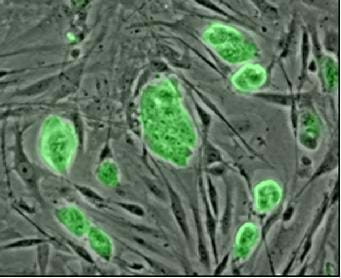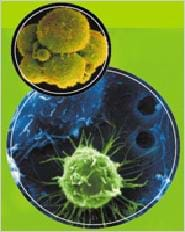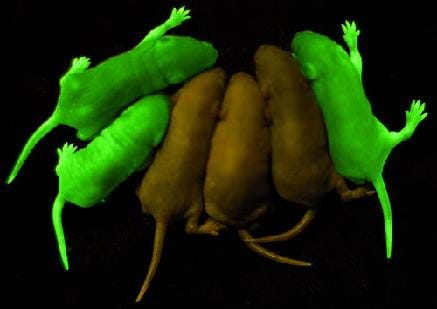Quick Look
Grade Level: 7 (6-8)
Time Required: 15 minutes
Lesson Dependency: None
Subject Areas: Biology, Life Science

Summary
Students continue their education on cells in the human body. They discuss stem cells and how engineers are involved in the research of stem cell behavior. Using the associated activity they learn about possible applications of stem cell research and associated technologies, such as fluorescent dyes for tracking the replication of specific cells.Engineering Connection
From engineering tools for observation on the molecular level to chemical and bioengineering of natural fluorescent dyes to the examination of cell replication in an organism, engineering developments and design have helped advance research of all types of cells. Engineering influences science and medical research by facilitating the understanding of how cells are influenced in all directions by their environment and how they behave in our bodies.
Learning Objectives
After this lesson, students should be able to:
- Define stem cells.
- List several applications of stem cells research.
- Describe engineering designs that are advancing stem cell research.
Educational Standards
Each TeachEngineering lesson or activity is correlated to one or more K-12 science,
technology, engineering or math (STEM) educational standards.
All 100,000+ K-12 STEM standards covered in TeachEngineering are collected, maintained and packaged by the Achievement Standards Network (ASN),
a project of D2L (www.achievementstandards.org).
In the ASN, standards are hierarchically structured: first by source; e.g., by state; within source by type; e.g., science or mathematics;
within type by subtype, then by grade, etc.
Each TeachEngineering lesson or activity is correlated to one or more K-12 science, technology, engineering or math (STEM) educational standards.
All 100,000+ K-12 STEM standards covered in TeachEngineering are collected, maintained and packaged by the Achievement Standards Network (ASN), a project of D2L (www.achievementstandards.org).
In the ASN, standards are hierarchically structured: first by source; e.g., by state; within source by type; e.g., science or mathematics; within type by subtype, then by grade, etc.
International Technology and Engineering Educators Association - Technology
-
Advances and innovations in medical technologies are used to improve healthcare.
(Grades
6 -
8)
More Details
Do you agree with this alignment?
State Standards
Colorado - Science
-
Gather, analyze, and interpret data and models on the functions and interactions of the human body
(Grade
7)
More Details
Do you agree with this alignment?
-
Gather, analyze, and interpret data and models on the different types of cells, their structures, components and functions
(Grade
7)
More Details
Do you agree with this alignment?
Worksheets and Attachments
Visit [www.teachengineering.org/lessons/view/cub_cells_lesson03] to print or download.Pre-Req Knowledge
Students should have knowledge of the parts of a cell and cell function.
Introduction/Motivation
We have cells throughout our entire body.... thousands upon thousands of cells. Who can tell me what cells do? They keep us alive! They are the foundation of life and without them; there would be no life on Earth. We have so many cells throughout our bodies that it is hard to count them all. Does anyone have any guesses on how many cells are in an average human body? About 100 trillion! They are typically very small, around 10 μm – that's smaller than the diameter of a human hair. (Fun Fact: The largest known single cell is actually quite large – an ostrich egg!)
We have about 210 different types of cells in our bodies, with each having a different function, or job, to keep us alive and healthy. Blood and immune system cells, including red and white blood cells, keep blood running through our body to our organs and help fight off illness. Brain cells, including neurons, carry electrical signals through our brains, transmitting information and instructions. When we are in class, our brain cells are working to store new information that is being learned, while at the same time, also carrying information to different parts of the brain to tell our bodies to keep our hearts beating and our lungs breathing so we stay alive.
Since cells are so important, what can we do if our cells get "sick"? Well, among trying to return the cells to a healthy state, some people believe stem cells are the answer to treating life-threatening diseases or medical conditions. While controversial (that is, meaning people disagree about it), stem cell research is a popular research subject now.
Lesson Background and Concepts for Teachers
Cancer, one of the main causes of death in America, is a disease in which one type of cell divides and replicates rapidly within tissue that has a specific type of cell needed for proper body function. What do you imagine might happen if "sick" blood cells began dividing rapidly in our brains and invading the space that neurons usually occupy? How would our bodies know to keep our hearts beating and lungs breathing if neurons began to be replaced by blood cells? Among many treatment options for cancer are surgery and chemotherapy. The goal of surgery is to entirely remove the cancer cells. Unfortunately, this is not always possible, and much depends on where the cancer is actually located. Chemotherapy, on the other hand, is not the removal of the "sick" cells, but the interference with cell division to destroy cell life and additional cell growth. However, the chemotherapy process targets all rapidly dividing cells, not just cancer cells, which can then affect other "healthy" cells in the body, such as hair and intestinal cells, causing a person to get sick from the treatment procedure itself.
Another treatment option being researched involves the use of a certain type of cell called stem cells. Does anyone know what a stem cell is? Two types of stem cells are: embryonic stem cells, found in a developing human embryo, and adult stem cells, found in umbilical cord blood and bone marrow (see Figure 2). Stem cells have the ability to replicate themselves by mitosis and be grown and differentiated into the many cells in our bodies, including different types of muscle and brain cells. In adult humans, stem cells work to replace damaged tissue but are also involved in normal regeneration of cells, such as skin and blood. Embryonic stem cells can actually regenerate into more than 200 types of adult cells, given the right environment and stimulation for that cell type. The applications of stem cells for medical therapies include treatments of cancer and spinal cord injuries, among others.

Researching how stem cells behave in our bodies is crucial before stem cell treatments can be used. Engineers play a big part in this research. One engineering design currently being researched is the development of a three-dimensional microscopic housing structure that would allow scientists to look at stem cell behavior from every direction. This is very important since stem cells are indeed affected from all directions. For example, if we were looking for an apartment in a multi-story building and we were told that the noise level of the next-door neighbors was very low, we would be very disappointed if we moved in and found out that the residents below and above us were extremely loud. It is clear to us, then, that we did not have all of the information needed before we chose that apartment. Without an engineered technology to analyze stem cells from every direction, scientists would not have all the information they need to develop safe and effective medical treatments.
Another key role of engineers in stem cell research is developing ways to track stem cell behavior once injected into an organism. Chemical engineers helped to develop different fluorescent proteins that act as markers based on naturally occurring fluorescent proteins in jellyfish. These green fluorescent proteins (GFPs) can be linked to naturally-occurring proteins and injected into an organism, such as a mouse (Refer to the Glowing Flowers activity to have students learn about engineering design of GFP's and expand their understanding of the role they play in stem cell research). The mouse then produces fluorescent green, protein-linked cells, including stem cells, which can be extracted and injected into another mouse to see where the new fluorescing stem cells travel (see Figure 3). Shining a blue light onto the mouse causes the GFPs to glow brightly and easily be seen. The injected stem cells with GFPs (see Figure 1) can then be easily traced to see if they move toward a certain part of the body and what type of cells they differentiate into within the animal.
The Controversy
Stem cells are currently a controversial topic because the use of embryonic stem cells involves either the destruction of a human embryo or therapeutic cloning of cells, which is the basis of cloning animals and possibly even humans. Research is being done to find a way to generate embryonic stem cell lines without the destruction of embryos. Little controversy exists with the use of adult stem cells found in adult tissues. In fact, adult stem cells have been used for years to treat leukemia and bone cancers through bone marrow transplants.

Arguments against embryonic stem cell research include concerns around reproductive cloning and challenges to personal or religious beliefs. Arguments for embryonic stem cell research include insistence that stem cells are necessary for the advancement of medical science and may save lives. Proponents of stem cell research position that the only embryos used for research are those that would be discarded anyway. The social and ethical challenges behind stem cell research have had a large impact on government funding and regulations.
Associated Activities
- Glowing Flowers - Students learn about engineering design of green fluorescent proteins (GFPs) and their use in stem cell research. Teams use a fluorescent dye mixed in water to follow the movement of water through a plant and extend their knowledge to GFP-linked cells moving through an animal organism.
Lesson Closure
Stem cells are able to replace themselves and be grown and differentiated into the various cell types in our bodies. Stem cell research has looked at using stem cells to replace damaged tissue and regenerate cells like skin and blood. The applications of stem cells for medical therapies include treatments of cancer and spinal cord injuries. Engineers are highly involved in stem cell research. They design the technologies that lead to the understanding of stem cells, their structure, and how they differentiate into other cells. Engineers also develop ways to find and track stem cells when placed into different environments. One example is the development of green fluorescent proteins (GFPs) that have been injected into mice to follow the replication and differentiation of stem cells. Can you think of other ways that engineers are involved in the medical field? (Ask students to get into groups of three and write or draw pictures of engineering applications that involve cells and medical research. Discuss these as a group.)
Vocabulary/Definitions
fluorescence: Bright light shining from an object as a result of high energy photons (light), such as ultraviolet light or x-rays.
green fluorescent protein: (GFP) A dye created by engineers to simulate naturally occurring fluorescence in jellyfish.
stem cell: A cell that is able to replace itself and differentiate into another cell type in the body.
Assessment
Pre-Lesson Assessment
Discussion Question: Ask a discussion question to get students thinking about the upcoming lesson. Write student responses on the board. After soliciting answers, explain that these questions will be answered during the lesson. Leave the responses on the board and refer to them for discussion throughout the lesson. Ask the students:
- What are cells? Give me your definition.
- What are stem cells?
Post-Introduction Assessment
Question/Answer: Ask the students questions and have them raise their hands to respond. Write their answers on the board.
- What are stem cells? (Answer: A cell that is able to replace itself and transform into another cell type in the body.)
- Why are scientists interested in learning more about stem cells? (Answer: They may have medical applications that could help treat specific diseases and injuries.)
- How do engineers make it possible for scientists to study stem cells? (Answer: They create instruments to look at the stem cells from every direction and develop specialized proteins to study stem cells in animals.)
Lesson Summary Assessment
Engineering Impacts: Engineers have to think about the broader impacts of a design when developing new systems and technologies. Have the students, in pairs or as small groups, think about the different considerations an engineer would likely think about when designing technologies for stem cell research. Some of these might include the impacts on individuals, society and the environment, as well as ethical, economic, social and political considerations.
Lesson Extension Activities
Court is in Session: Ask the class to split into two groups: one in support of stem cell research and one against it. Have each team research the controversy behind stem cell research. Ask each team to prepare an argument to bring to "court." This should include drawings on butcher paper, diagrams, facts referenced from a reliable source, pros and cons, etc. A simple debate can be performed, or each team can choose a couple of witnesses (such as an engineer and a politician, etc.) and a couple of lawyers to question the witnesses from the other team. The judge can be the teacher. Opening and closing arguments should be similar to having a debate.
Cancer and HeLa Cells: Introduce students to HeLa Cells by having them read individually the Cancer and HeLa Cells Lesson Extension handout. Have students follow the links below to learn more about HeLa cells. If desired, have students conduct further research and write a report about their findings and the many uses of HeLa cells. Another option is to have a class debate in which students argue whether it was right or wrong to use Henrietta's cells without her consent.
- A video explaining the origin and application of HeLa cells can be found at: http://www.cbsnews.com/stories/2010/03/15/sunday/main6300824.shtml
Subscribe
Get the inside scoop on all things TeachEngineering such as new site features, curriculum updates, video releases, and more by signing up for our newsletter!More Curriculum Like This

Student teams learn about engineering design of green fluorescent proteins (GFPs) and their use in medical research, including stem cell research. They simulate the use of GFPs by adding fluorescent dye to water and letting a flower or plant to transport the dye throughout its structure.

Students learn about the major components and functions of the immune system and the role engineers play in keeping the body healthy through the design of medical care such as vaccinations and antibiotics. They also learn how an astronaut's immune system is suppressed during spaceflight due to stres...

This lesson covers the topic of human bones and joints. Students learn about the skeleton, the number of and types of bones in the body, and how outer space affects astronauts' bones. Students also learn how to take care of their bones here on Earth to prevent osteoporosis ─ or weakening of the bone...

After learning, comparing and contrasting the steps of the engineering design process (EDP) and scientific method, students review the human skeletal system, including the major bones, bone types, bone functions and bone tissues, as well as other details about bone composition. Students then pair-re...
References
Geijsen, Niels. Massachusetts General Hospital, National Science Foundation, Office of Legislative and Public Affairs, NSF PR 03-142 - December 10, 2003, accessed October 3, 2008. <http://www.nsf.gov/od/lpa/news/03/pr03142_images.htm>
U.S. National Institutes of Health, National Institute of Child Health and Human Development, July 18, 2006, accessed October 3, 2008. <http://www.nichd.nih.gov/news/releases/green_brown_mice.cfm>
U.S. National Institutes of Health, National Institute on Aging, "Chapter 5: The Future of Aging," January 31, 2008, accessed October 3, 2008. <http://www.nia.nih.gov/HealthInformation/Publications/AgingUndertheMicroscope/chapter05.htm>
Copyright
© 2008 by Regents of the University of Colorado.Contributors
Christie Chatterley; Malinda Schaefer Zarske; Janet Yowell; Victoria Lanaghan; Megan ShawSupporting Program
Integrated Teaching and Learning Program, College of Engineering, University of Colorado BoulderAcknowledgements
The contents of this digital library curriculum were developed under a grant from the Fund for the Improvement of Postsecondary Education (FIPSE), U.S. Department of Education and National Science Foundation GK-12 grant no. 0338326. However, these contents do not necessarily represent the policies of the Department of Education or National Science Foundation, and you should not assume endorsement by the federal government.
Last modified: May 30, 2019









User Comments & Tips